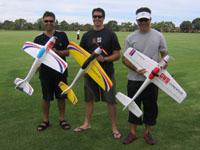Easy
Start to Radio Control Model Planes
by Keith Lightbody
last updated 5 March 2007
Success Factors: When starting this hobby avoid
complex, expensive or cheap products that are difficult to build or fly. I spent
a lot of time watching other RC fliers to identify value in this potentially
expensive sport. Look for model planes that match your flying level - you need
air time to develop good stick skills - so pick something that will have you
up in the sky as much as possible. Make sure you have a look at a RC simulator
- although expensive it will save you a fortune and improve your flying skills
fast! I believe electric RC park flyers are a sensational development - they
are neighbour friendly, a great source of local entertainment, economical and
allow flying before or after work rather than waiting for the weekend. However
it is essential to fly safely in public places - your
local park is not recommended for learning - practise away from the public until
you can consistently takeoff and land safely.
| Things for
Success |
TRAINER

-stable (much easier to fly)
-slow (easier to land)
e.g. Max shown above
-robust (cope with poor landings)
e.g. Aerobird
BUT
-less aerobatic |
SIMULATOR

-HIGHLY RECOMMENDED!
-saves a fortune (free crashes)
-allows regular practice (rain okay)
-learn characteristics of many models
BUT
-need a modern computer
-require good graphics card |
MATES

-answer silly questions
-know about clubs
-share fun of flying
-help with technique
-show repair tricks
BUT
-have to work |
| SPACE
-large, clear, flat area
-avoid trees, power lines, fences
BUT
-practice spot landings |
WEATHER
-start with light, smooth winds
-avoid thermals, gusts when learning
-use websites showing wind strength
(e.g. SeaBreeze.com) |
LITHIUM
-lighter batteries
-longer flight times
BUT
-more expensive |
RADIO
-test controls before flying
-recommend computer based
(easy to adjust sub-trim, travel) |
RECEIVER
-use long range (less worry)
-buy quality equipment |
CONNECTORS
-firm connection
-totally reliable
-label clearly
-same as mates if possible |
TOOLKIT
-put selection of tools in a case
-include spare parts, tape, etc
-take case to flying site |
PROPELLORS
-find cheap replacements
-consider a prop saver
-folding props have low drag |
MOTORS
-recommend reliable models
-rear facing good for beginners
-start with economical models |
FAMILY

-enjoy time outdoors
-helps parent child bonding |
CHARGER

-smart charger Pb/NiCd/NiMH/Li
-know how much charge added
-relax while charging (set & forget)
BUT
-relatively expensive
-charge in a safe location |
FUN

-I fly for fun! In the park out the front of my house there are some friendly
magpies that often follow my planes around the park. I also enjoy the
greater flying skill required to take clean catches with my gliders. |
Basic plane e.g. Aerobird ARF
Good points:
pusher prop - engine does not hit
dihedral wing - more stable flight
robust body - take a few crashes
spare parts - can buy replacements e.g. wing
Bad points:
non standard - custom servos, radio
V tail - good but not highly manoeverable
Basic batteries e.g. 600 mAh NiMH
Good points:
widely available
Bad points:
short flight times - around 10 minutes
Basic charger e.g. 12 V car outlet
Good points:
charge in car on way to flying
Bad points:
slow charge - around 1 hour
Better plane e.g. Wattage Max series
Good points:
greater control - rudder, elevator, aileron (optional)
standard parts - wide choice of servos, receivers, props, etc
Bad points:
less robust - requires reinforcing (I have used light weight 1 and 2 mm carbon
fibre rods with great success)
Better batteries e.g. 1200 or 2400
mAh LiPo
Good points:
much lighter and smaller batteries
much longer flight times with less weight
Bad points:
more expensive
Better charger e.g. Swallow
Good points:
safer - intelligent charging, auto cutout
multiple battery types - Pb/NiCd/NiMH/Li
flexibility - charge/discharge/cycle options
adjustable charge rates -
charge at flying site - use spare 12 V car battery
Bad points:
only 12 V input - requires transformer for charging at home
Terms
Used in Radio Control Model Plane Flying
ARF - Almost Ready to Fly
Computer Radio - suits airplanes, helicopters or gliders -
offer model memory, adjustable travel and trim, reversible servo direction,
etc. One major advantage is it avoids the need for physical adjustments of control
rods or servo arms.
LiPo - Lithium polymer
mAh - milli Ampere hour (measure of power capacity or how much
'charge' is available for use in a battery - 1200 mAh is twice as powerful as
600 mAh)
NiCd - Nickel Cadmium
NiMH - Nickel Metal Hydride
Pb - Lead
Please take the trouble to offer ideas or suggestions - you
will be acknowledged and others can benefit.
This site is intended to be free of bias and receives no commercial gain from
any party.
Statistics on useage of
this site are gathered by ChilliTech web stats.





